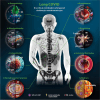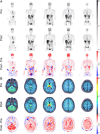Long COVID - a critical disruption of cholinergic neurotransmission?
- PMID: 40011942
- PMCID: PMC11866872
- DOI: 10.1186/s42234-025-00167-8
Long COVID - a critical disruption of cholinergic neurotransmission?
Abstract
Background: Following the COVID-19 pandemic, there are many chronically ill Long COVID (LC) patients with different symptoms of varying degrees of severity. The pathological pathways of LC remain unclear until recently and make identification of path mechanisms and exploration of therapeutic options an urgent challenge. There is an apparent relationship between LC symptoms and impaired cholinergic neurotransmission.
Methods: This paper reviews the current literature on the effects of blocked nicotinic acetylcholine receptors (nAChRs) on the main affected organ and cell systems and contrasts this with the unblocking effects of the alkaloid nicotine. In addition, mechanisms are presented that could explain the previously unexplained phenomenon of post-vaccination syndrome (PVS). The fact that not only SARS-CoV-2 but numerous other viruses can bind to nAChRs is discussed under the assumption that numerous other post-viral diseases and autoimmune diseases (ADs) may also be due to impaired cholinergic transmission. We also present a case report that demonstrates changes in cholinergic transmission, specifically, the availability of α4β2 nAChRs by using (-)-[18F]Flubatine whole-body positron emission tomography (PET) imaging of cholinergic dysfunction in a LC patient along with a significant neurological improvement before and after low-dose transcutaneous nicotine (LDTN) administration. Lastly, a descriptive analysis and evaluation were conducted on the results of a survey involving 231 users of LDTN.
Results: A substantial body of research has emerged that offers a compelling explanation for the phenomenon of LC, suggesting that it can be plausibly explained because of impaired nAChR function in the human body. Following a ten-day course of transcutaneous nicotine administration, no enduring neuropathological manifestations were observed in the patient. This observation was accompanied by a significant increase in the number of free ligand binding sites (LBS) of nAChRs, as determined by (-)-[18F]Flubatine PET imaging. The analysis of the survey shows that the majority of patients (73.5%) report a significant improvement in the symptoms of their LC/MEF/CFS disease as a result of LDTN.
Conclusions: In conclusion, based on current knowledge, LDTN appears to be a promising and safe procedure to relieve LC symptoms with no expected long-term harm.
Keywords: Cholinergic neurotransmission; Flubatine; Long COVID; Low dose transdermal nicotine; Nicotinic acetylcholine receptors; Spike glycoprotein.
© 2025. The Author(s).
Conflict of interest statement
Declarations. Ethics approval and consent to participate: The patient in question consented to the examination and the individual treatment attempt after being informed in detail. Consent for publication: All authors have approved the content of the manuscript, agreed to its publication, and accepted responsibility for the work. Competing interests: The authors declare no competing interests.
Figures


References
-
- Abbate G, De Iulio B, Thomas G, Priday A, Biondi-Zoccai G, Markley R, u. a. Postural Orthostatic Tachycardia Syndrome After COVID-19: A Systematic Review of Therapeutic Interventions. J Cardiovasc Pharmacol. 2023;82(1):23–31. - PubMed
-
- A clinical practice guideline for treating tobacco use and dependence: A US Public Health Service report. The Tobacco Use and Dependence Clinical Practice Guideline Panel, Staff, and Consortium Representatives. JAMA. 2000;283(24):3244–54. - PubMed
Publication types
LinkOut - more resources
Full Text Sources
Research Materials
Miscellaneous
